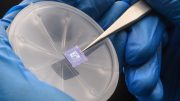
The vertical electrochemical transistor is based on a new kind of electronic polymer and a vertical, instead of planar, architecture. Credit: Northwestern University
Efficient, low-cost transistors have a wide range of applications, including biomedical sensing.
A multidisciplinary Northwestern University research team has created a groundbreaking transistor that is expected to be optimal for bioelectronics that are high-performance, lightweight, and flexible.
The new electrochemical transistor is compatible with both blood and water and has the ability to amplify significant signals, making it highly beneficial for biomedical sensing. This transistor could make it possible to develop wearable devices that can perform on-site signal processing right at the biology-device interface. Some potential applications include monitoring heart rate and levels of sodium and potassium in the blood, as well as tracking eye movements to study sleep disorders.
“All modern electronics use transistors, which rapidly turn current on and off,” said Tobin J. Marks, a co-corresponding author of the study. “Here we use chemistry to enhance the switching. Our electrochemical transistor takes performance to a totally new level. You have all the properties of a conventional transistor but far higher transconductance (a measure of the amplification it can deliver), ultra-stable cycling of the switching properties, a small footprint that can enable high-density integration, and easy, low-cost fabrication.”
Marks is a world leader in the fields of materials science and organic electronics. He is the Vladimir N. Ipatieff Professor of Catalytic Chemistry in the Weinberg College of Arts and Sciences and professor of materials science and engineering and chemical and biological engineering in the McCormick School of Engineering.
The vertical electrochemical transistor is based on a new kind of electronic polymer and a vertical, instead of planar, architecture. It conducts both electricity and ions and is stable in air. The design and synthesis of new materials and the transistor’s fabrication and characterization required the collaborative expertise of chemists, materials scientists, and biomedical engineers.
Marks led the research team along with Antonio Facchetti, research professor of chemistry at Weinberg; Wei Huang, now a professor at the University of Electronic Science and Technology of China; and Jonathan Rivnay, professor of biomedical engineering at the McCormick School.
“This exciting new type of transistor allows us to speak the language of both biological systems, which often communicate via ionic signaling, and electronic systems, which communicate with electrons,” Rivnay said. “The ability of the transistors to work very efficiently as ‘mixed conductors’ makes them attractive for bioelectronic diagnostics and therapies.”
This study detailing the efficient electrochemical transistor and an accompanying News & Views article were recently published in the journal Nature.
“With their vertical architecture, our electrochemical transistors can be stacked one on top of another,” Facchetti said. “Thus, we can make very dense electrochemical complementary circuits, which is impossible for the conventional planar electrochemical transistors.”
To make more reliable and powerful electronic circuits, two types of transistors are needed: p-type transistors that carry positive charges and n-type transistors that carry negative charges. These types of circuits are called complementary circuits. The challenge researchers have faced in the past is that n-type transistors are difficult to build and are typically unstable.
This is the first work to demonstrate electrochemical transistors with similar and very high performance for both types (p+n) electrochemical transistors. This resulted in the fabrication of very efficient electrochemical complementary circuits.
Reference: “Vertical organic electrochemical transistors for complementary circuits” by Wei Huang, Jianhua Chen, Yao Yao, Ding Zheng, Xudong Ji, Liang-Wen Feng, David Moore, Nicholas R. Glavin, Miao Xie, Yao Chen, Robert M. Pankow, Abhijith Surendran, Zhi Wang, Yu Xia, Libing Bai, Jonathan Rivnay, Jianfeng Ping, Xugang Guo, Yuhua Cheng, Tobin J. Marks and Antonio Facchetti, 18 January 2023, Nature.
DOI: 10.1038/s41586-022-05592-2
The study was funded by the Air Force Office of Scientific Research, the Northwestern University National Science Foundation Materials Research Science and Engineering Center, and the National Natural Science Foundation of China.









Be the first to comment on "Wearable Electronics Breakthrough: A Revolutionary Electrochemical Transistor"